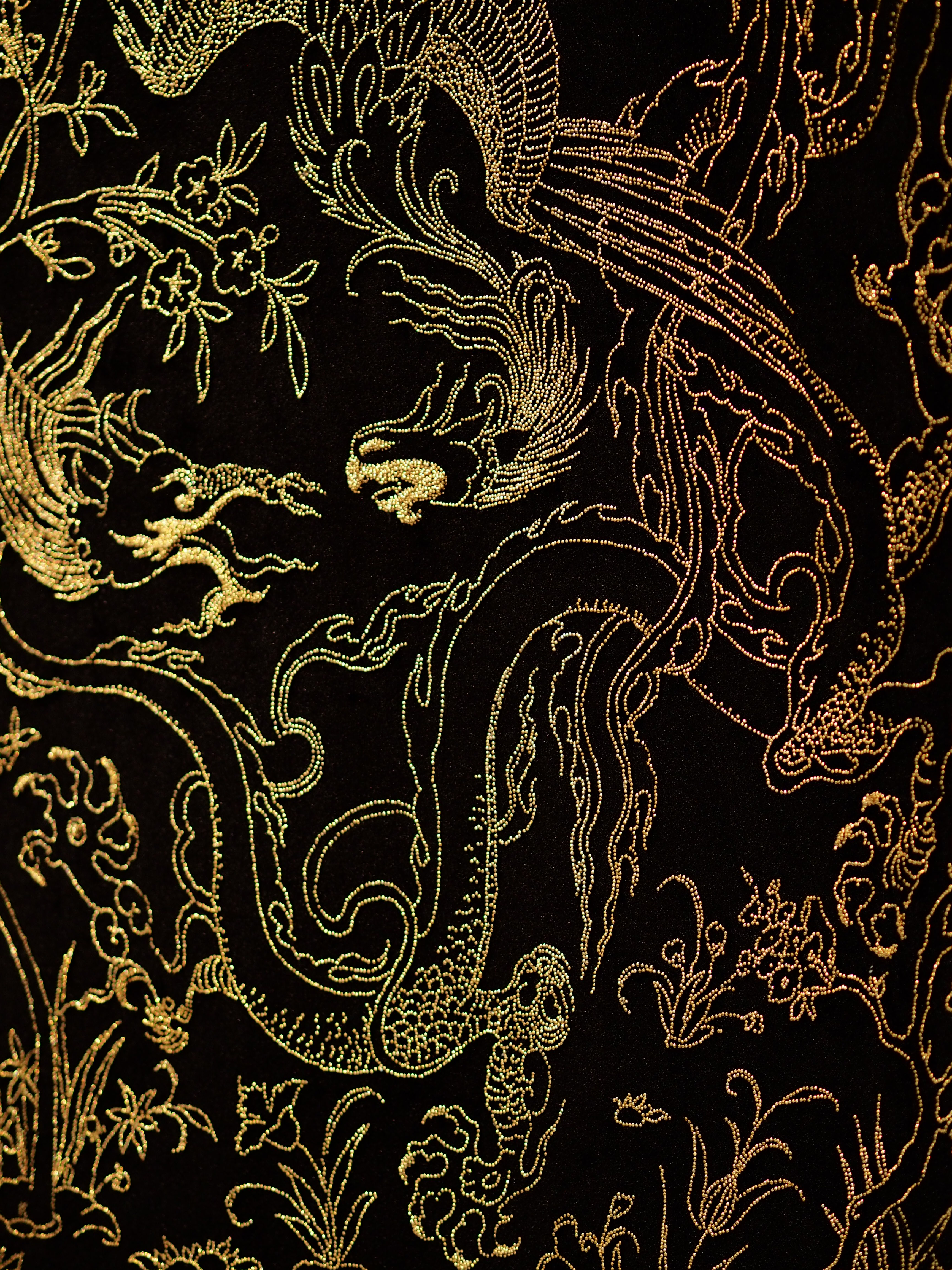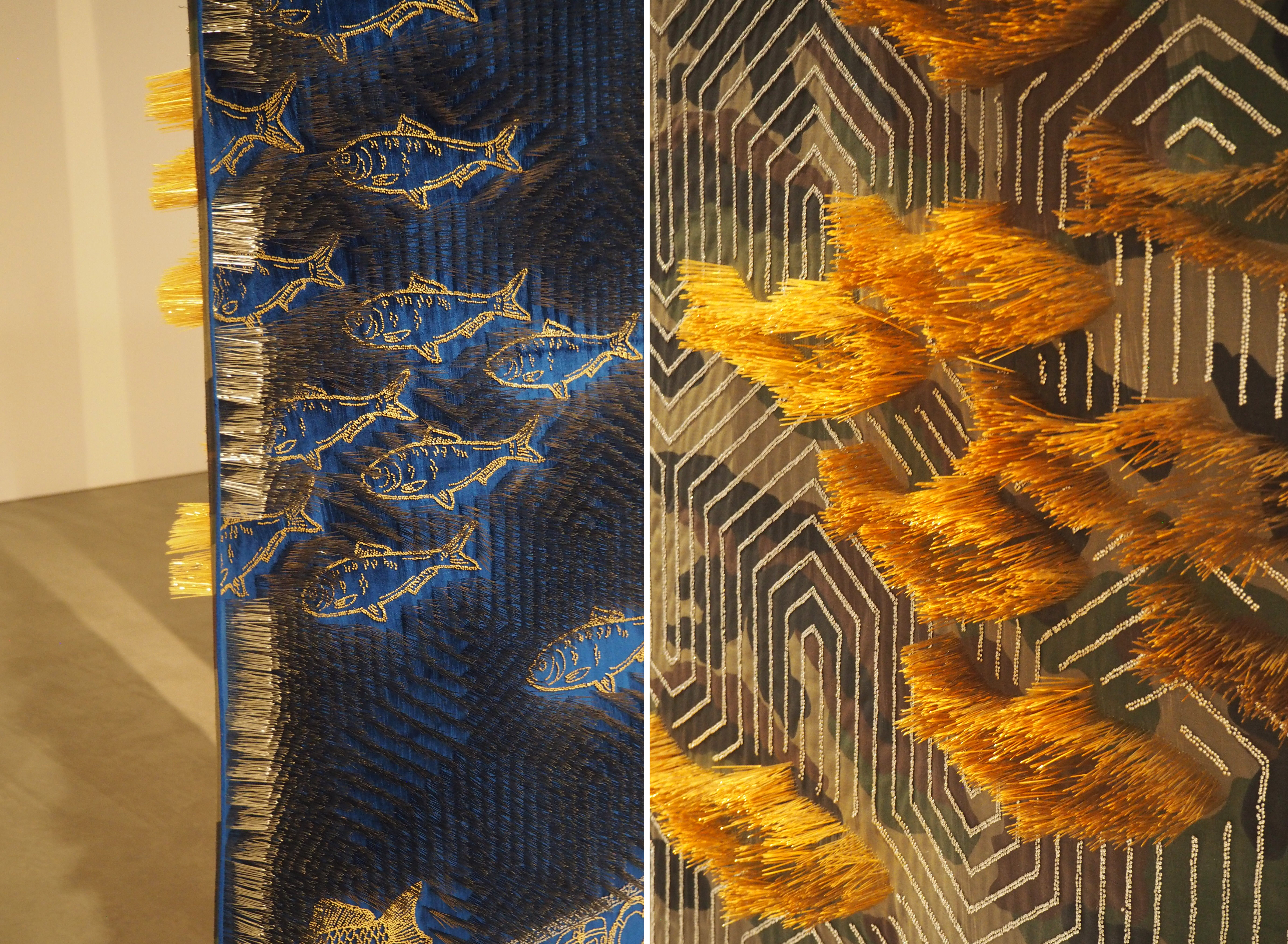While there is often a lot to be gleaned from the subject matter explored in art, there are instances when an artist’s choice of materials and techniques can make the meanings and ideas expressed in his/her artwork even more profound. I’ve chosen to share the work of two very unique APT9 artists, who have produced enormous commissions for the exhibition, with two key elements in common; both are comprised of thousands of objects intrinsically connected to cultural heritage and personal histories, and both have been shaped by empowering and meaningful practices and techniques.
Aisha Khalid – Water has never been afraid of fire
Aisha Khalid was born, and continues to work in, Lahore in Pakistan. Her work is reflective of her studies in Persian and Mughal art, which are renowned for sophisticated displays of majesty, the use of luminous, lavish materials, and techniques of painstaking accuracy and remarkable geometrical precision. Khalid’s works demonstrate her refined skills in miniature painting, textile practices she learnt from her mother, the influences of Sufi music and philosophy, and the splendour of Mughal gardens and architecture throughout the city. Embedded within her reach into these traditions is also a desire to probe and challenge cultural conventions, and an ability to bring new life to objects and meanings.
Khalid draws upon the potential of textiles in her large-scale suspended triptych (almost five meters in length) Water has never been afraid of fire. She considers the symbolism of more traditional embroidery, and its place in the domestic lives of women today, but introduces new approaches that confront and upturn the accepted customs associated with the craft. While conventional forms of embroidery might be contained, intimate and delicate, Khalid’s textiles are imposing and unyielding bearers of complex patterns inspired by Persian carpets and historical paintings – on an architectural scale.

Fabric, gold-plated and steel pins
Triptych: 492.75 x 167.65cm; 492.75 x 83.8cm;492.75 x 83.8cm
Commissioned forAPT9
Collection: Queensland Art Gallery I Gallery of Modern Art
The detail in the central panel comes from the design of the four-quartered garden of the Charbagh, which is based on the Islamic garden from the Qur’an, a symbol for paradise on earth. The four gardens of paradise (soul, heart, spirit and essence) are bound by four water channels, or, the rivers of paradise. The two outer panels feature watery patterns, sea creatures and vessels which symbolise trade and human movement across water.

At first glance, it appears that Khalid has applied traditional embroidery techniques with golden thread to tell a story supported by a plethora of culturally significant symbols, patterns and motifs. However, upon closer inspection, it becomes apparent that the images take shape not by stitches, but by the labour-intensive process of piercing multiple layers of fabric with countless gold-plated and steel pins.

Khalid applied to produce the artwork. It is not immediately noticeable from the viewing the front of the artwork.
Yes, the design is made entirely OF PINS. (Yes. That is correct. You may need to take a moment to consider the magnitude of this fact.)

and the lengths of the pins shown protruding through the back of the fabric (right)
Marrying the aesthetics of traditional embroidery with this innovative use of such a humble but domestically significant object (or hundreds of thousands of them) turns a commonly accepted two-dimensional piece of embellished fabric into something three-dimensional, sculptural and probably very heavy. All three pieces are extremely fragile, and – according to the GOMA floor guide – were quite the challenge to conserve, transport and unveil.
While she possesses a rich understanding of technical and symbolic concepts pertinent to age-old traditions, Kahlid simultaneously honours and challenges their existence and significance in her world – and our world – today. By introducing a revitalised, contemporary and bold approach to working within a traditional form, she is, in a way, contributing to not only its survival, but its evolution.
Jonathan Jones – Untitled (giran)
Jonathan Jones is a Wiradjuri man now living and working in Sydney. His work, produced in collaboration with revered Elder and Wiradjuri language specialist, Dr Uncle Stan Grant Snr, AM (father of well-known journalist Stan Grant) is untitled, but is accompanied by the word “giran” in parentheses. “Giran” is the Wiradjuri word for wind, but is also a term describing fear or apprehension. For Jones, the wind is an important part of understanding country; winds carry, spread and pass on knowledge, encourage change, and propel new ideas towards those who are willing to listen.

Untitled (giran) is comprised of about 2,000 individual sculptures that look like six kinds of traditional tools, each type made from a different material. Together, the tools make up a swirling Mobius strip formation that reflects the motion and currents of the wind, evocative of a murmuration of birds in communal flight. The six tools that make up the work are:
- Bagay – an emu eggshell spoon
- Galigal – a stone knife
- Bingal – an animal bone awl
- Bindu-gaaany – a freshwater mussel scraper
- Dhala-ny – a hardwood spear point
- Waybarra – a base, or the beginnings of, a woven basket made from rush


These tools allowed people to eat, hunt, gather, sustain and protect. Each represents knowledge that is spread and passed down through generations, and embodies the potential for not only survival but change.

Attached to each tool is a small cluster of feathers bound by pieces of handmade string. Jones collected these feathers with the help of people from all over Australia, who became willing collaborators and contributors to the artwork when they sent him packages of feathers. Collaboration and communal acts of making and creating are paramount to Jones’ practice. While he made many of the tools himself, he worked on this part of the project with family members, the wider Wiradjury community and long-term artistic collaborators. For Jones, the process of making brings people together, enhances connections to the land, strengthens culture and language, and reinforces links to generations who have passed on.

Untilted (giran) is accompanied by a stirring soundscape. While viewing the work as a sweeping whole, or observing the detail in individual tools, visitors can hear the rush of the wind, birds calling, tools clicking and clacking, and Wiradjuri language whispered softly in collective murmurs.
Bindu-gaany (freshwater mussel shells), gabudha (rush), gawurra (feathers), marrung dinawan (emu egg), wambuwung dhabal (kangaroo bone), wayu (string), wiiny (wood).
48-channel soundscape, installation dimensions variable.
Sound design: Luke Mynott. Courtesy: The artists
While the Wiradjury language may be at risk, for Dr Uncle Stan Grant Snr, this work represents the continuation and development of Wiradjury philosophy. Untitled (giran) shares tradition and knowledge and seeks to foster change, growth and the exchange of ideas. It serves as a reminder – through its conception, development, creation and presence – that language and knowledge are extremely valuable, very much like any precious inheritance passed from one generation to the next.

Loving the pieces on Indigenous art and the stories that go with them. There are some fabulous stories and its great to see the artistic interpretations.
LikeLike
Indigenous art is so rich in narrative, and there is so much to learn, understand and appreciate through engaging with Indigenous works of art.
LikeLike